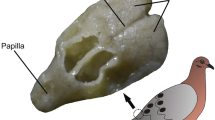Abstract
Hume’s ground jay (Pseudopodoces humilis), a species living in the high altitude steppes of the Qinghai-Tibet-Plateau (China), was traditionally thought to be a ground jay related to the genus Podoces (Corvidae). Recently, however, based on three independent datasets (comparative osteology, nuclear and mitochondrial DNA sequences), this species was discovered to be a member of the Paridae. Here, we reinvestigate the systematic position of Pseudopodoces humilis using the chemical composition of uropygial gland secretions, which have previously been shown to be phylogenetically informative in birds, including Corvidae and Paridae. We found strong similarities in the fatty acid composition of uropygial gland secretions between Pseudopodoces humilis and parids, but clear differences from corvids. This result supports the parid affinites of Pseudopodoces, but stands in contrast to behavioural and vocal characteristics which are clearly more similar to corvids than to parids.
Similar content being viewed by others
References
Amadon D (1944) The genera of Corvidae and their relationships. Am Mus Novit 1251:1–21
Bianki W (1907) Mongolii i vostochnago Tibeta. Aves expeditions P.K. Kozlowi po Mongoliam et Tibetiam orientalem :4–5
Borecky SR (1978) Evidence for the removal of Pseudopodoces humilis from the Corvidae. Bull BOC 98:36–37
Clench MH (1985) Body pterolysis of Atrichornis, Menura, the “corvid assamblage” and other possibly related passerines (Aves: Passeriformes). Rec Aust Mus 37:115–142
Gebauer A, Kaiser M (1998) Zwerglaufhäher (Pseudopodoces humilis)—die Springbälle Tibets. J Orn 139:212
Gebauer A, Kaiser M (2000) Der Zwerglaufhäher (Pseudopodoces humilis)—ein “Exot” vom Dach der Erde, Freilanduntersuchungen und Welterstzucht in Menschenobhut. Tagungsband XXI. Tag Trop Vögel Ges Tropenornithol :11–13
Goodwin D (1986) Crows of the world, 2nd edn. British Museum (Nat Hist), London
Hartert E (1894) On little known and undescribed eggs from the Kuku-Noor. Novit Zool I:673
Hartert E (1910) Die Vögel der paläarktischen Fauna,. vol I. Friedländer, Berlin, p 40
Hartert E, Steinbacher F (1932) Die Vögel der paläarktischen Fauna, Ergänzungsband. Friedländer, Berlin, p 30
Hope S (1989) Phylogeny of the avian family Corvidae. PhD dissertation. City University of New York
Hume A (1871) Stray notes on ornithology in India. Ibis Ser 3,1:403–413
Jacob J (1980) The pattern of uropygial gland secretions as a chemotaxonomic parameter in avian systematics. Acta Congr Int Ornithol 17(2):1221–1225
Jacob J, Grimmer G (1973) Zusammensetzung der Bürzeldrüsensekrete der Dohle (Coloeus monedula), Raben- (Corvus corone corone) und Nebelkrähe (Corvus corone cornix). Z Naturforsch 28c:75–77
Jacob J Hildebrandt A (1983) Chemische Verwandtschaft zwischen Zaunkönigen (Troglodytidae) und Meisen (Paridae). Funkt Biol Med 2:115–118
Jacob J, Ziswiler V (1982) The uropygial gland. In: Farner DS, King SR, PARKS KC (eds) Avian biology, Vol VI. Academic Press, London, pp 199–323
Jacob J, Balthazart J, Schoffeniels E (1979) Sex differences in the chemical composition of uropygial gland waxes in domestic ducks. Biochem Syst Ecol 7:149–153
James HF, Ericson PGP (2000) An overlooked species of tit in a novel adaptive zone for the Paridae. Joint Millenium Meeting of the AOU, BOU and SCO, Newfoundland, 14–19 August 2000
James HF, Ericson PGP, Slikas B, Lei FM, Gill FB, Olson SL (2003) Pseudopodoces humilis, a misclassified terrestrial tit (Paridae) of the Tibetan Plateau: evolutionary consequences of shifting adaptive zones. Ibis 145:185–202
Kleinschmidt O, Weigold H (1922) Corvidae, Certhiidae, Sittidae, Paridae, Cinclidae, in: Zoologische Ergebnisse der Walter Stötznerschen Expeditionen nach Szetschwan, Osttibet und Tschili auf Grund der Sammlungen und Beobachtungen Dr. Hugo Weigolds. Abh Ber Zool Anthropol-Ethnogr Mus Dresden XV, 3, 1:1–18
Londei T (1998) Observations on Hume’s groundpecker Pseudopodoces humilis. Forktail 14:74–75
Londei T (2002) Hume’s groundpecker Pseudopodoces humilis: the smallest corvid or the largest tit? Orient Bird Club Bull 36:52–53
Ludlow F (1928) Birds of the Gyantse neighborhood, southern Tibet. Part II. Ibis Ser 12, 4:54–55
Ludlow F, Kinnear N (1933) A contribution to the ornithology of Chinese Turkestan, Pt. 2. Ibis Ser 13, 3:445–449
Madge S, Burn H (1994) Crows and jays. Black, London
Meinertzhagen R (1926) Introduction to a review of the genus Corvus. Novit Zool 33:57–121
Poltz J, Jacob J (1974a) Waxes of the uropygial gland secretion of birds of the genus Parus. Biochem Biophys Acta 360:348–356
Poltz J, Jacob J (1974b) Die Bürzelsekrete von Eichelhäher (Garrulus glandarius), Elster (Pica pica), Alpendohle (Pyrrhocorax graculus) und Kolkrabe (Corvus corax). Z Naturforsch 29c:239–242
Sharpe RB (1877) Catalogue of the birds in the British Museum, vol III. British Museum, London, p 152
Vaurie C (1959) The birds of the Palearctic fauna. Passeriformes Witherby, London, p 156
Wang G, Lei FM, Tang JY, Yi F (2003) Sexual and geographic phenotypic variation of the brown ground chough Pseudopodoces humilis in the Tibetan plateau, China. Acta Zootax Sinica 28:196–201
Zarudny N, Loudon H (1902) Über die Einteilung des Genus Podoces in subgenera. Ornithol Mber 10:185
Acknowledgements
We would like to thank the taxidermists of the Museum für Tierkunde Dresden for the extraction of the uropygial gland. The chemical analysis of the uropygial gland secretion was financially supported by the Research Fund of Deutsche Ornithologen-Gesellschaft. Our thanks go to Prof. Jochen Martens (Mainz) for valuable comments on the manuscript and to Marina Proutkina for help with the translation.
Author information
Authors and Affiliations
Corresponding author
Additional information
Communicated by A.J. Helbig
Rights and permissions
About this article
Cite this article
Gebauer, A., Jacob, J., Kaiser, M. et al. Chemistry of the uropygial gland secretion of Hume’s ground jay Pseudopodoces humilis and its taxonomic implications. J Ornithol 145, 352–355 (2004). https://doi.org/10.1007/s10336-004-0030-0
Received:
Revised:
Accepted:
Published:
Issue Date:
DOI: https://doi.org/10.1007/s10336-004-0030-0




